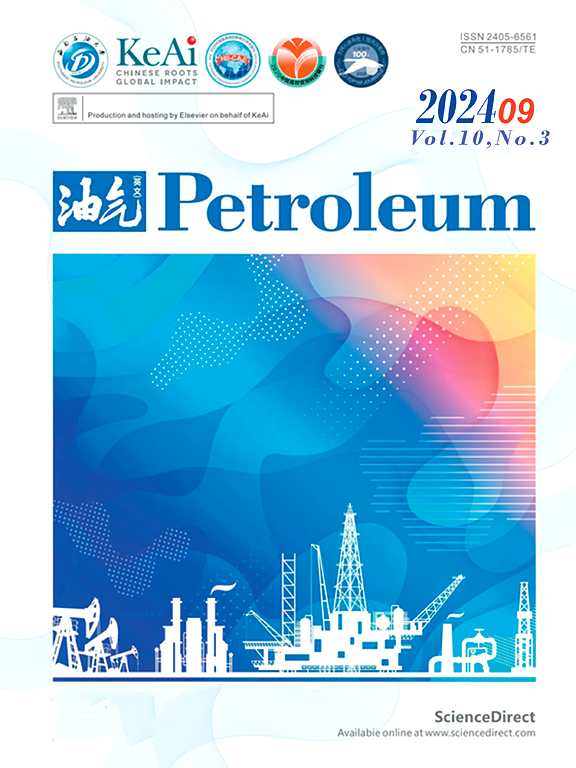Development directions of formation damage evaluation and fracturing fluids in tight and shale oil reservoirs
IF 4.2
Q2 ENERGY & FUELS
引用次数: 0
Abstract
Tight and shale oil reservoirs are characterized by small pore throats, low porosity, and low permeability, which must be stimulated to increase production. Fluid flow experiences a multi-scale transport process, starting from the matrix pore throats, extending to the natural fractures, and reaching the hydraulic fractures. Initially, tight and shale oil wells exhibit high production rates after hydraulic fracturing. However, this rapidly decreases due to insufficient energy in the reservoir, as well as formation damage to the reservoir, which impedes the multi-scale transport process. Consequently, effective systems for low-damage slickwater fracturing fluids and clean fracturing fluids to ensure the scale and effective development of tight and shale oil reservoirs after volume stimulation have been widely used. The pressure decay method and high back pressure displacement method have provided the valuable foundations for selecting fracturing fluids for tight and shale oil reservoirs. Nonetheless, challenges such as slow fluid transfer unpropped fracture closure, and water-phase trapping damage in tight and shale oil reservoirs need to be addressed urgently. Therefore, integrating fracture preservation, energy enhancement, and damage removal concepts will be essential for successful reservoir stimulation in tight and shale oil reservoirs. Additionally, exploring matching formation damage evaluation and fracturing fluid optimization technologies is crucial to achieving the efficient development of tight and shale oil reservoirs. These will all improve fracture stimulation effects and reservoir recovery, ultimately maximizing the reservoir potential.
致密油和页岩油储层损伤评价及压裂液研究的发展方向
致密油和页岩油储层具有孔喉小、孔隙度低、渗透率低的特点,必须对其进行增产处理。流体的流动经历了一个多尺度的输运过程,从基质孔喉开始,延伸到天然裂缝,最后到达水力裂缝。最初,致密油和页岩油在水力压裂后表现出较高的产量。然而,由于储层能量不足,以及地层对储层的破坏,阻碍了多尺度运移过程,这一数值会迅速下降。因此,高效的低损伤滑溜水压裂液和清洁压裂液体系被广泛应用,以确保致密油和页岩油储层在体积改造后的规模和有效开发。压力衰减法和高背压驱替法为致密油和页岩油储层压裂液的选择提供了有价值的依据。尽管如此,诸如流体输送缓慢、无支撑的裂缝闭合、致密油和页岩油储层中的水相圈闭损害等挑战仍亟待解决。因此,整合裂缝保护、增强能量和去除损害的概念对于致密油和页岩油储层的成功增产至关重要。此外,探索相匹配的地层损害评价和压裂液优化技术对于实现致密油和页岩油储层的高效开发至关重要。这些都将提高裂缝增产效果和油藏采收率,最终使油藏潜力最大化。
本文章由计算机程序翻译,如有差异,请以英文原文为准。
求助全文
约1分钟内获得全文
求助全文
来源期刊

Petroleum
Earth and Planetary Sciences-Geology
CiteScore
9.20
自引率
0.00%
发文量
76
审稿时长
124 days
期刊介绍:
Examples of appropriate topical areas that will be considered include the following: 1.comprehensive research on oil and gas reservoir (reservoir geology): -geological basis of oil and gas reservoirs -reservoir geochemistry -reservoir formation mechanism -reservoir identification methods and techniques 2.kinetics of oil and gas basins and analyses of potential oil and gas resources: -fine description factors of hydrocarbon accumulation -mechanism analysis on recovery and dynamic accumulation process -relationship between accumulation factors and the accumulation process -analysis of oil and gas potential resource 3.theories and methods for complex reservoir geophysical prospecting: -geophysical basis of deep geologic structures and background of hydrocarbon occurrence -geophysical prediction of deep and complex reservoirs -physical test analyses and numerical simulations of reservoir rocks -anisotropic medium seismic imaging theory and new technology for multiwave seismic exploration -o theories and methods for reservoir fluid geophysical identification and prediction 4.theories, methods, technology, and design for complex reservoir development: -reservoir percolation theory and application technology -field development theories and methods -theory and technology for enhancing recovery efficiency 5.working liquid for oil and gas wells and reservoir protection technology: -working chemicals and mechanics for oil and gas wells -reservoir protection technology 6.new techniques and technologies for oil and gas drilling and production: -under-balanced drilling/gas drilling -special-track well drilling -cementing and completion of oil and gas wells -engineering safety applications for oil and gas wells -new technology of fracture acidizing
 求助内容:
求助内容: 应助结果提醒方式:
应助结果提醒方式:


